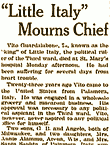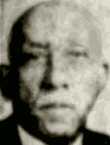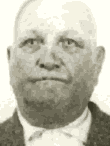

Due to its close proximity to Chicago, the Milwaukee Mafia Family has been strongly influenced by the Chicago Outfit. In its early years, the organization was little more than a remote branch of the Mafia of Sicily's Santa Flavia-Bagheria area. Following U.S. Mafia recognition of Al Capone's status as underworld boss in Chicago, a number of important Sicilian Mafiosi relocated from Chicago to Milwaukee, altering the character of the local underworld. The Milwaukee organization has historically been close to that of Kansas City, as both have contained members of the Balistrieri/Balestrere family. The Guardalabene family also had many members in both communities. The Milwaukee Outfit's territory is regarded as little more than the Milwaukee metropolitan area, but early in its history it may also have controlled the areas of Madison, Wisconsin, and Rockford, Illinois.

Obituary
1903 - Vito Guardalabene (Born Sept. 26, 1945, in Santa Flavia, Sicily. Died Feb. 6, 1921, in Milwaukee, WI.) Guardalabene is the earliest Milwaukee Mafia boss of record. Guardalabene left his native town of Santa Flavia in 1903 and sailed from Naples to New York aboard the S.S. Umbria. He was on his way to join his sons Angelo and Giovanni Battista, already settled on Milwaukee's Detroit Street. It is worth noting that members of the Mafia-linked Balistrieri family, from the village of Aspra within the Santa Flavia municipality, were present in Milwaukee for a decade before Guardalabene's arrival. One of the Balistrieris - or one of Guardalabene's sons - may have served as an undocumented Mafia boss in the area before Vito Guardalabene's arrival. Guardalabene was naturalized a U.S. citizen in February 1911.
1915 - The supremacy of Vito Guardalabene over the Milwaukee region's Sicilian underworld around 1915 was noted in the memoirs of Nick Gentile. In the Little Italy of Milwaukee's Third Ward, Guardalabene was said to be "the king." Though he never ran for public office, Guardalabene was considered the political ruler of the Third Ward.
1921 - Giovanni Battista Guardalabene (June 14, 1881, in Porticello, Santa Flavia, Sicily. Died June 14, 1949, in Milwaukee, WI.) Upon Vito Guardalabene's death, his son Giovanni Battista - referred to as "Peter" in some records - briefly took over the leadership of the local Mafia. Proving the tight-knit nature of the Mafia in this period, Guardalabenes lived on Milwaukee's Detroit Street as close neighbors to other leaders in the Zarcone and Balistrieri clans. Calogero "Charlie" Zarcone later served as consigliere in the Milwaukee family and Frank and Peter Balistrieri later served as bosses.

D'Amato
1924 - Giuseppe D'Amato (Born c1885, in Santa Flavia, Sicily. Died March 28, 1927, in Milwaukee, WI.) Leadership of the Milwaukee Mafia seems to have been shared between Giovanni Battista Guardalabene and a distant relative known as "Big Joe" Amato, real name Giuseppe D'Amato. However, the FBI and the Senate Permanent Subcommittee on Investigations believed that Guardalabene turned over complete control of the Mafia to Amato in 1924. Little is known for certain about Amato and his activities. (Research is made difficult by the number of similarly aged Giuseppe Amatos and Giuseppe D'Amatos in that time and place and by a frustrating lack of newspaper coverage.) He entered the United States as an adult and settled in the Little Sicily of Milwaukee's Third Ward, where Guardalabenes and Balistrieris were numerous. Late in 1910, he married Stefana Pizzo, recently arrived from Santa Flavia. They had several children together, while living at 231 Jefferson Street.
1927 - Whether ruling alone or in partnership with Giovanni Battista Guardalabene, Amato's reign was short. At just forty-one years of age, Amato became seriously ill in the winter of 1926-27 and succumbed to pneumonia on March 28, 1927.

Vallone
1927 - Joseph Vallone (Born Sept. 8, 1885, in Prizzi, Sicily. Died March 18, 1952, in Milwaukee, WI.) Following the death of Amato, control of the Milwaukee Mafia seems to have slipped from the grasp of the Santa Flavia-area Mafiosi. The next recognized boss, Joseph Vallone, was a native of the inland Sicilian town of Prizzi. Vallone reached the U.S. in October of 1907 and joined an uncle in Milwaukee. A decade later he and Pasquale Migliaccio formed a wholesale grocery company, Migliaccio & Vallone (later Pioneer Food Company). During Prohibition, their grocery, at 146 Buffalo Street, was a supplier of sugar and other moonshining supplies. Vallone, his wife and their daughter lived across the street. The grocery and the Vallone home moved to Jefferson Street by 1930.
1928 - Between the late 1920s and the early 1930s, a number of Chicago's Sicilian mafiosi relocated into the Milwaukee area and were absorbed into the Milwaukee Crime Family.
1930s - In the early 1930s, a federal grand jury indicted Vallone, along with Third Ward political power Angelo Guardalabene and 43 other defendants, for participating in a regional bootlegging syndicate. In this period, the U.S. Mafia consolidated organizations in American cities (outside of New York, where five families were permitted to operate independently). If there had been some level of independence between the Prizzi and Santa Flavia organizations in Milwaukee, it would have ended at this time under the leadership of Vallone.
1933 - With alcohol once again legal, Vallone and Migliaccio opened the Broadway Liquor Company. Vallone's underworld administration in the period reportedly included Joe Gumina as underboss and Charles Zarcone as consigliere (the duties of the consigliere are uncertain, but Zarcone's inclusion in leadership indicates that the Prizzi and Santa Flavia mafiosi were contained within a single organization at this time). During the 1930s, the FBI heard that Vallone was turning operations over to his relative Salvatore "Sam" Ferrara. It appears, however, that Vallone did not fully enter retirement until late in the next decade. He died March 18, 1952, following a long illness.

Ferrara
c.1949 - Salvatore "Sam" Ferrara (Born Feb. 23, 1896, in Prizzi, Sicily. Died April 12, 1974, in Milwaukee.) Ferrara was the second and last Milwaukee Mafia boss to be a native of Prizzi. In addition to sharing the same Sicilian hometown, Ferrara and Joseph Vallone were related. Ferrara entered the U.S. late in 1913, initially settling with a cousin in Rock Island, Illinois. For a time after moving to Milwaukee, Ferrara remained employed by a Rock Island company. In Milwaukee in 1926, he married Laura Marino, daughter of local mafioso Nicola Marino and sister of tavern owner Santo Marino. (Laura Marino was related by marriage to important local mobster John DiTrapani.) Giovanni Battista Guardalabene served as best man. For many years, Ferrara ran the Peacock Bar at 1447 Van Buren Street. He then opened Central Liquor Mart at 1125 North Jackson Street. It appears that Joseph Vallone groomed Ferrara for years as his successor. Ferrara had a strong relationship with underboss Joe Gumina. Ferrara's daughter married into the Gumina family. Charles Zarcone, a remnant of the old Santa Flavia-based regimes, appears to have retained his position as consigliere in the Ferrara administration.
1952 - Sam Ferrara quarreled with Frank Peter Balistrieri, a member of the old Santa Flavia faction and son-in-law of influential local mafioso John Alioto (Frank Balistrieri married Alioto's daughter Antonina "Nina"). The cause of the quarrel reportedly was a Ferrara attempt to acquire an ownership share in Balistrieri's Ogden Social Club gambling hall. Irritated by Balistrieri's resistance, Ferrara expelled Balistrieri from the Milwaukee Mafia. This fractured the Milwaukee underworld and triggered the involvement of Chicago Outfit leaders, responsible for overseeing Milwaukee under the Commission system established in the early 1930s. A panel of Chicago gangsters - FBI reported Anthony Accardo, Rocco Fischetti and Sam Giancana took part - ruled that Ferrara had abused his authority. The Chicagoans demoted Ferrara and installed John Alioto as new boss. Ferrara seems to have remained a Mafia member but became largely inactive. He died in 1974 at the age of seventy-seven.

Alioto
1952 - John Alioto (Born Aug. 25, 1888, in Porticello, Santa Flavia, Sicily. Died Aug. 27, 1972, in Milwaukee, WI.) The decision of Chicago Outfit leaders restored the power of the Milwaukee Mafia's Santa Flavia faction, excluded from the crime family's top spot for a period of twenty-five years. Alioto had served time in prison in the 1930s, following convictions for forgery and larceny. He and his wife Catherine raised a large family on Van Buren Street. His administration included underboss Joe Gumina and lieutenants Mike Mineo, Pasquale Migliaccio, John DiTrapani and Alioto's son-in-law Frank Peter Balistrieri (restored to Mafia membership following the removal of Sam Ferrara as boss). During his reign, disputes within the family were resolved by a leadership panel, called "sagia."
1954 - Shortly after becoming boss, Alioto was faced with an insurrection. John DiTrapani, relative and godson of Sam Ferrara, plotted with Frank LoGalbo and Jack Enea to take control of the crime family. The rebellion was put down with the murders of John DiTrapani and Jack Enea in 1954. Frank LoGalbo avoided a similar fate by quickly transfering out of the Milwaukee crime family and into a Chicago Outfit regime in Chicago Heights. He continued to reside in Milwaukee under Chicago protection.

Balistrieri
1961-1962 - Frank Peter Balistrieri (Born May 27, 1918, in Milwaukee, WI. Died Feb. 7, 1993, in Milwaukee, WI.) FBI heard conflicting reports about Balistrieri's selection as boss. Some said that Alioto trained him for the post through years and handed him the reins in December 1961 or January 1962. Others said that Alioto went into retirement at that time, opposed to the idea of Balistrieri becoming boss, preferring someone older and more experienced. FBI heard that Alioto was angered by a Balistrieri romantic relationship outside of his marriage to Alioto's daughter. (These apparently conflicting reports may both be true - Alioto may have intended Balistrieri to succeed him and then had second thoughts when the affair came to light.)
Balistrieri sought to increase the crime family's wealth and influence by assessing a street tax on gambling racketeers and a number of legitimate businesses. He brought in Joseph Gurera and Buster Balestrere from Kansas City to enforce that protection racket. Balistrieri managed to anger segments of his organization by elevating the newcomer Gurera to capodecina rank, as well as by doing away with the "sagia" dispute resolution process and acting in an autocratic manner. Balistrieri was protected against rebellion through his close relationship with Chicago Outfit leaders, particularly Felix "Milwaukee Phil" Alderisio.
He could not protect himself against the U.S. government, however. In the late 1960s, he was sentenced to two years in federal prison for tax evasion. In the 1980s, his participation in extortion and Las Vegas casino skimming rackets were exposed. In 1984, he was sentenced to thirteen more years in federal prison.
Rat Trap: "Joey G drops a dime and a body or two" by Edmond Valin
1984 - Peter Balistrieri (Born Sept. 12, 1919, in Milwaukee, WI. Died Aug. 16, 1997, in Milwaukee, WI.) With Frank Balistrieri heading off to prison for a long sentence, his brother Peter Balistrieri took temporary control of crime family operations. Peter had previously served as a capodecina over a younger Milwaukee Mafia faction.
1991 - Frank Peter Balistrieri was released from federal prison at Butner, North Carolina, in 1991. He died of a heart attack in 1993. Brother Peter died a few years later.